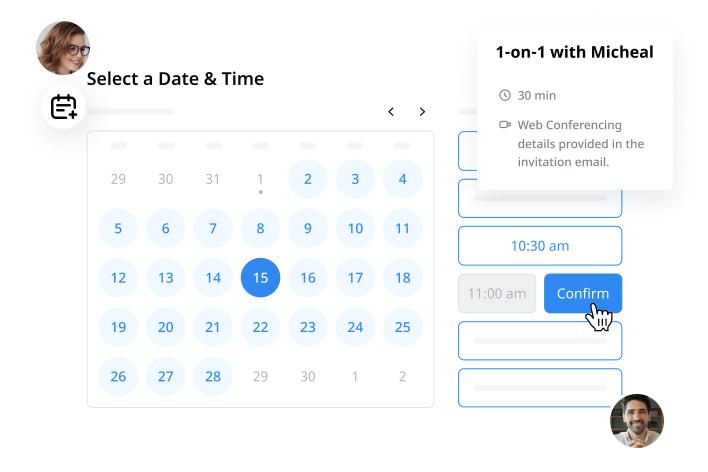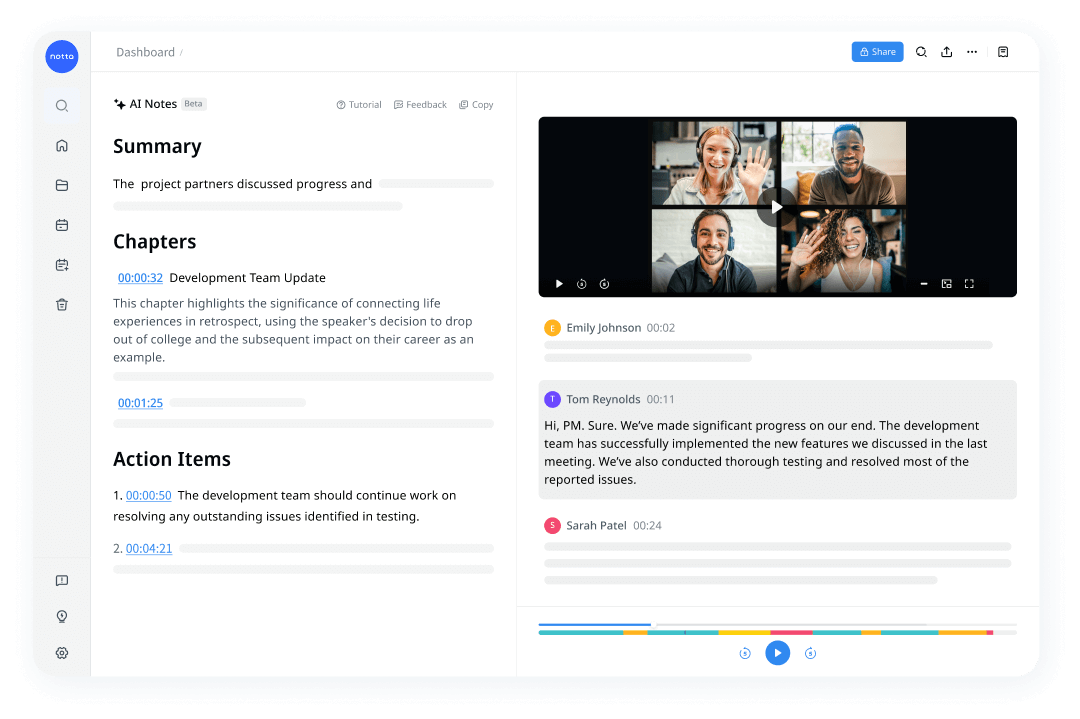
How to Deliver an Effective Sales Demo that Converts (9 Steps)
Record, transcribe and summarize conversations with one click.
Picture this: you are sitting across from a potential client, armed with your product or service and ready to make your pitch. But as soon as you begin your sales demo, you notice their eyes have become unfocused and their attention begins to wander. Sound familiar?
A sales demo can be the difference between making or breaking a deal, and every salesperson understands its importance.
However, conducting a sales demo call that converts requires careful planning and a thorough understanding of the prospect’s peculiar needs. You must also be able to engage your audience and retain their attention throughout your presentation.
If you are not sure what all these entail, don’t worry. In this article, we'll explore the art of the sales demo and provide you with practical tips to ensure your next one not only impresses but also converts prospects into paying customers.
Let’s get right into it!
What is a sales demo?
A sales demonstration, short for sales demonstration, is a presentation delivered by a sales rep to showcase a product or service to a potential customer, convincing them to make a purchase.
This practice includes showcasing the features, capabilities, and value of the product in an interactive manner, and most importantly, demonstrating how it can meet the customer's needs and solve their pain points.
Remember, an effective sales demonstration should communicate the value proposition of the product, generate interest, and motivate prospects to take the next step in the sales process.
When do you conduct a sales demo?
Sales demos typically occur when the visitor has shown interest in the product or service (that is, becomes a lead) and is considering making a purchase decision.
The timing for this depends on the user’s buying journey; and here are some specific points when you might consider delivering a sales demo:
When a visitor fills out an online form and requests more information
When a lead contacts the sales team to learn more about your product or service
When you identify a customer's pain points and believe the product or service can help
As a general rule, sales demos are often necessary when the qualified lead is interested but hesitant to make a purchase or requires more information or reassurance before committing.
Where is a sales demo held?
A sales demo can be conducted in various settings depending on the nature of the product or service and the preferences of the audience. The common options include
In-person: Best for a physical product because the prospect can touch and test it. The demo can be held at the company’s office, at a trade show, or on-site at a customer's location.
Live meeting: Best for a SaaS or software sales demo. Virtual sales demos have become increasingly popular with the rise of remote working. It can be conducted using video conferencing software such as Zoom, or Google Meet, which allows easy screen sharing and face-to-face chat.
Automated/pre-recorded video: Best for asynchronous communication. A sales demo can also be pre-recorded and sent to the prospects to give them an overview of the product or service.
Phone call: Best when the customer already knows the product and only has a few questions to ask.
Differences between a product demo and a sales demo
People often confuse these two kinds of demos because they are both presentations given to showcase a product or service. However, they serve distinct purposes, have unique emphasis, and are for different target audiences.
Audience
The audience for a sales demo typically consists of potential customers who are already interested in the product or service while a product demo targets a broader audience, including potential customers, existing customers, or even internal stakeholders.
Purpose
The primary purpose of a sales demo is to persuade and convert potential customers into paying customers. A product demo, on the other hand, educates and provides an in-depth understanding of the features, functionality, and capabilities of a product for existing customers.
Emphasis
In a sales demo, the emphasis is on the value proposition and benefits that the product or service can deliver to the customer. A product demo places more emphasis on the technical details, functionality, and specific features of the product.
Call to action
The ultimate goal of a sales demo is to drive a specific call to action, such as scheduling a follow-up meeting, signing a contract, or making a purchase.
On the other hand, while a product demo may include a call to action, such as requesting a trial or further exploring the product's features, it is generally less focused on immediate sales conversion and more centered on educating and informing the audience about the product.
With Notta, you can easily generate meeting minutes, turning spoken content into written records with 98.86% accuracy.
How to conduct a sales demo that sells?
Regardless of whether you work in B2B or B2C sales, you can follow the steps below to conduct an impactful sales demo and also tweak the steps to suit your sales demo goals and remain cordial.
Step 1: Know your product (and your competitor’s)
Product knowledge is an indispensable part of effective sales.
You must have a solid grasp of the product before you can persuade leads to make a purchase. So, take some time to try it out and understand its features, use cases, and what makes it unique. Understanding its shortcomings and conditions necessary for optimal performance is also important.
Next, learn about your close competitors’ products and offerings and compare them to yours. What are the best use cases and best features of their product? How does their price point compare to ours? Do they offer technical support like we do?
This might be a little nerve-wracking, but it also allows you to create a more persuasive presentation. Knowing your product’s strong and weak points when placed side-by-side with the competition can help you highlight why yours is better overall and provide great responses to the prospect’s objections.
Step 2: Research your prospect and their needs
Before conducting a sales demo, it's important to understand your audience. A good place to start is by exploring their website or social media to access public information. You can also directly ask the prospect questions to gather insights.
What does their company do and what is their vision?
What specific issues are they experiencing?
Doing this will make it easy to tailor your demo to address customers’ pain points and showcase how your offering can benefit them directly. Also, by demonstrating that you've done your homework, you will earn their confidence and establish a strong foundation for a compelling presentation.
Step 3: Confirm the sales demo
Once you’ve determined who to invite, you should immediately find available time for your demo.
Instead of exchanging several emails to decide on what time works for both parties, you can use a meeting scheduling software to share your open hours with the lead and align on a convenient time easily.

After agreeing on a time to hold the sales demo, send an invite to all the participants. The invite should contain details of the time and location of the demo, as well as other helpful information.
It’s recommended to send an email reminder one day or a few hours before the meeting to ensure that your prospect does not forget.
Step 4: Determine your selling approach
To determine the right selling approach, you must put yourself in your prospect’s shoes and consider what they would find persuasive. While the point of any demo sales presentation is to show what your product can do, it’s equally important to show how it can be adapted to the needs of the prospect.
To achieve this, there are two critical aspects to keep in mind:
Show your understanding: The initial research you have carried out on the prospect is helpful. Acknowledge their pain points at the beginning of your demo and then present your product or service as a solution.
Use storytelling: Storytelling is an effective way to engage your prospect. By showing that you've helped existing clients with similar challenges, the prospect will relate to them and be convinced.
Step 5: Prepare your demo agenda
A well-planned agenda ensures a focused and impactful sales demo. So, it is important to create one and share it with your prospects prior to the demo to keep them aligned.
Outline the main topics you will cover and allocate appropriate time for each item to avoid rushing or overrunning.
Ideally, the agenda should also include interactive elements to encourage participation and allow Q&A time for feedback and discussion.
Step 6: Start with a strong opening
Your opening sets the tone for the entire sales demo, so start strong.
Don’t start like a demo robot by saying, “Hi, I’m Tobi. Let’s start our sales demo now.” Rather, take a minute or two to break the ice by making small talk. This is your opportunity to build a rapport with the prospect, get a bit more comfortable, and ease into your presentation.
Then you can give a brief summary of your presentation so the prospect knows what to expect and remains intrigued. It is generally advisable to limit this to three main points. For example, your summary to be sound something like this,
“Firstly, I will provide a brief overview of the XYZ product and its key features. Then, I will demonstrate how it works. And finally, I will show you how you can use it to improve efficiency in your business processes by 80%.”
Step 7: Showcase the product
Now we come to the critical step: explaining the product or service to your potential customers and achieving your goal.

You can begin by giving a background of why the product or service exists and the main problems it was made to solve.
Your approach should not be to simply list a bunch of nice-sounding features but to demonstrate how your product or service offerings cater to their needs. You can also paint a vivid picture of how your product integrates seamlessly into their workflow or how it resolves their challenges more effectively than any alternative.
By positioning your product as a solution, you will create a strong imperative for your audience to make a purchase!
Step 8: Encourage and answer questions
After you are done with your presentation, ask the prospect if they have any questions, comments, or concerns. This is your opportunity to erase any doubt left in their minds and to strengthen the case you have made for your product.
When answering a question, make sure that your responses are direct and specific. Avoid long, complicated explanations that are irrelevant to the prospect.
In case you don’t know an answer, avoid guessing and giving wrong information, simply admit that you’re not sure and promise to provide an answer afterward.
Step 9: Close the demo and follow up
Whew! You’ve completed another sales demo. Now the big question: is the prospect interested in moving forward?
At the end of each sale demo, a salesperson should clearly communicate the next steps that prospects are expected to take, whether it's sending a follow-up email, signing up for a trial, or making a purchase. A strong call to action ensures that the momentum you've built during the demo translates into concrete action and converts.
Also, you need to be proactive in following up with the prospect to address any remaining questions or concerns and move the sales process forward.
Pro tips for effective sales demonstration
If you are looking to nail your sales demonstration every time, here are the best practices for you.
1. Adopt a customer-centric approach
“Approach each customer with the idea of helping him or her solve a problem or achieving a goal, not of selling a product or service” - Brian Tracy
This suggestion by Brian Tracy presents a revolutionary way of approaching sales. Focusing on your sales target alone might make you lose sight of the prospect’s interests and many prospects can tell when you do not care.
However, adopting a customer-centric approach will translate to helping the prospect achieve their goals, gaining their trust, and closing the deal. And this is the ideal scenario for all involved.
2. Record your virtual sales demo
Recording sales demo calls provides you with a valuable repository of information that can be analyzed to gain insights into individual conversations with leads, your sales approach, and specific areas of improvement in your presentation. These recordings can also be used for sales training.

And for this purpose, we recommend the Notta AI meeting assistant, and for good reasons:
Notta is compatible with popular conferencing platforms like Zoom, Google Meet, and Teams.
Record a sales call in high-quality audio and video and you can rewatch it later.
Generate a transcript for your sales demo in real-time and you can mark highlights for easy reference later.
Its integration with CRM like Salesforce allows you to import customer data in one click.
Before recording a meeting, however, you must understand the legal requirements and ethical best practices for obtaining, using, and disposing of recordings. For example, it is often legally required that you obtain consent from the meeting participants and notify them before you start recording.
3. Keep your presentation clear and simple
Your presentation should be clear and easy to understand. Avoid using jargon or technical terms that may confuse the prospect.
Concisely present the information, noting the most important points without overwhelming the prospect with excessive details.
Practicing your lines adequately and becoming familiar with your presentation before the demonstration is also helpful in helping you tidy up your oral and visual presentations. Ensure that you internalize the flow of your analysis and points and can deliver them simply.
4. Don’t just tell, show
The goal of your demo should be to show, not just tell. Prospects are likely to get bored of your presentation if it is too wordy or has too many textual elements.
In addition to this, people are visual learners, and relying solely on verbal explanations can limit the impact of your sales demo. So, instead of telling your prospect your point, show it to them using strong visual elements, such as images, videos, infographics, or charts. These will help to support your most important points and make the demo more engaging and memorable.
5. Use real-life examples
Incorporate storytelling techniques to engage the audience emotionally. Use relatable examples, customer testimonials, case studies, or success stories to demonstrate the product's impact and benefits in real-world scenarios. These show your credibility and expertise to the prospects.
If, however, you do not have real-life examples to share, you can paint a vivid picture of how your product or service can positively impact the prospect’s lives or businesses.
6. Be engaging and interactive
Instead of making your sales demo a one-way conversation, make it an engaging and interactive experience. Encourage your prospects to ask questions, provide feedback, and actively participate in the demo. You can also frame the different parts of the demo as questions encourage participation.
By fostering a two-way dialogue, you'll build rapport and address concerns in real-time. Remember, engagement leads to connection, and connection leads to conversions.
7. Tailor your presentation to your prospect’s needs
Do not use a generic presentation when you are meeting different clients. Whenever possible, personalize the sales memo to make the prospect feel valued and understood. The presentation should also show how the product can meet their requirements and deliver value that aligns with their goals.
Other things you can do include addressing the prospect by name and referencing previous conversations or interactions. Personalizing your presentation in this manner helps to create a sense of connection and relevance.
5 common mistakes to avoid when conducting a sales demo
Delivering a successful sales demo requires careful execution and avoiding common pitfalls that can hinder your chances of closing a deal. To ensure your sales demo is effective and impactful, here are seven mistakes to avoid:
1. Overwhelming prospects with features
Bombarding your prospects with a long list of features without clearly demonstrating how they provide value can confuse and disengage your audience. Instead, focus on highlighting the value of the product and its direct relevance to the prospect. It is also helpful to spotlight the features that are especially useful for the prospect.
For example, if they have a small team, it would be more useful to focus on how your product is designed to serve small teams than telling them that they can create a thousand staff user profiles.
2. Neglecting to listen to prospects
“Most people think that ‘selling’ is the same thing as ‘talking’. But the most effective salespeople know that listening is the most important part of their job” - Roy Bartell
A successful sales demo is not just about showcasing your product or service; it's also about actively listening to your prospects. Failure to listen to their concerns, questions, and feedback can create a disconnect and make your presentation feel one-sided.
3. Poor timing and pace
The timing and pace of your sales demo can significantly impact its effectiveness. Rushing through key points or dragging the presentation can lead to confusion or boredom. Maintain a steady pace, allowing your prospects to absorb the information while keeping their interest engaged.
It is also crucial to know when to stop. The volume and length of your presentation do not always equal effectiveness. So, keep the presentation concise and focused.
4. Failure to address objections
Your prospects may have concerns, objections, or questions during the sales demo. Brushing them aside or failing to address them adequately can create doubt and hinder the conversion process. Take the time to address their objections directly and provide satisfactory solutions or explanations.
Avoid being defensive or impatient with the prospect. Affirm their objections and address them instead of treating the objections like a personal affront.
5. Talking down on the competitors
While it may be tempting to criticize or undermine competitors to make your product or service look superior, it can backfire and damage your credibility.
Instead, focus on highlighting the value and benefits your offering brings to the table. Remember, the goal is to showcase the strengths of your product or service, not to tear down others.
Conclusion
In conclusion, conducting a sales demo that converts is not an impossible task and the learning curve is not too steep. However, you have to prepare diligently, have the right equipment and software, and deploy a customer-centric approach to succeed.